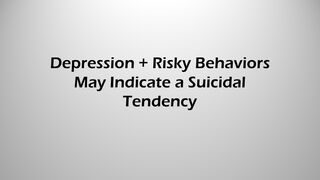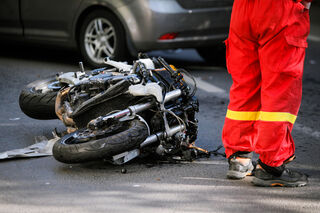Suicide
Reckless Driving as Possible Subconscious Suicidal Ideation
Reckless drivers may need screening for depression and suicidal tendencies.
Posted November 4, 2022 Reviewed by Devon Frye
Key points
- Agitation and reckless driving, when coupled with depression, may be a sign of suicidal tendencies.
- The call for a change in behavior, such as helmet-wearing and traffic obedience, is not enough to stop what is being called an "alarming trend."
- Perhaps it is time to screen those with reckless driving for agitation, depression, and suicidal ideation. Public safety may be enhanced.
The World Health Organization estimates that the pandemic has triggered a 25 percent worldwide increase in anxiety and depression. At the same time, several localities have reported a "disturbing trend" in motorcycle crashes, especially deadly ones. One report focusing on Washington state, for example, suggests that there were more motorcycle fatalities in 2020 than in any year since 1982. Many of these fatalities involve speeding, illegal passing maneuvers, or other reckless behavior.
How many of you reading this essay have seen, for instance, a motorcyclist speeding far beyond the legal limit, then going between lanes or outside of the legal lanes to pass others, with an apparent disregard for the life of others or for the self? I argue that some of these individuals who are driving particularly recklessly—cars as well as motorcycles—may very well have suicidal tendencies, or what I would label as subconscious suicidal ideation. Even sadder than this possible unconscious suicidal ideation is the disregard for the life of those who are hit by the one driving the vehicle. There seems to be a disregard for life in general—both one’s own and those who are victims of the crash.
Is there an established link between risky driving behavior and the motivation, even if subconscious, to take one's own life? If so, should the mental health community be more aware of this and start consistent screening procedures for suicidality when risky driving behavior is detected? And what besides risky driving might be associated with subconscious suicidal ideation? Let's see what research has found on these issues.
In one paper, presented at the 28th European College of Neuropsychopharmacology Congress in Amsterdam in August of 2015 (Popovic et al., 2015), the authors examined features that predict suicidality in patients with depression, coupled with certain bipolar features such as inflated self-esteem and a tendency to engage in behaviors that may have a high potential for painful consequences. This was a large-scale study of 2,811 participants from Bulgaria, Egypt, Morocco, the Netherlands, Portugal, Russia, Spain, and Turkey.

The results showed that the risk of attempted suicide was 50 percent greater for those with depression when the following features were present:
- Risky behaviors that include reckless driving
- Impulsivity with little or no forethought
- Nervous behaviors such as agitation
A related study (Ratte & Bergerson, 1997) compared young adult drivers (average age of 21) who were classified by their driving record as good, intermediary, or bad. They found a statistically significant difference among the three groups. Those with poor driving records had more "risk proneness while driving" and "distinctive characteristics of suicidal individuals" that did not seem to be conscious, similar to the theme of "little or no forethought" as reported by Popovic et al. (2015).
Another study by Sansone, Lam, and Wiederman (2010) reports a link between attempted suicide (not suicidal ideation, either overt or subconscious) and driving while intoxicated—certainly a risky behavior. Other risk-taking driving behaviors (besides intoxication) in this study did not relate to suicide attempts. As far back as 1964, the psychiatrist J.M. MacDonald suggested in a series of case studies that some people seek suicide while driving as a means to avoid the "disgrace" of an actual report of suicide.

Because the numbers of those with suicidal tendencies and ideation are very small relative to all drivers, one cannot necessarily observe this phenomenon by overall traffic accidents or fatalities. Instead, the hint at the validity of this hypothesis is in the individual case studies, such as the pioneering work of MacDonald (1964).
When faced with a client who is engaging in reckless driving behavior, then, it may be prudent for clinicians to consider a depression diagnosis. Popovic et al. conclude that it is important to assess symptoms such as reckless driving and agitation in all patients who are diagnosed with a major depressive episode. The authors state that this insight into the link between depression and risky behavior and impulsivity has important therapeutic implications.
So yes, I argue that mental health professionals should screen depressed patients for risky behavior and suicidal tendencies as suggested seven years ago by Popovic et al. (2015). In addition, perhaps it is time to flip this around and assess those who engage in reckless driving for depression and possible suicidal ideation, even the subconscious form, for the sake of these drivers—and for those unsuspecting ones driving near them.
A further focus on a lack of meaning and purpose in the person’s life (what Dr. MacDonald in 1964 called a discouraged state), which can accompany depression, may be important in this diagnostic battery. As Viktor Frankl (1969) made clear, a lack of meaning in one’s life is associated with physical demise, which in the case here may manifest as endangered driving.
A focus only on exhortations to be vigilant while driving or to wear a helmet is not looking deeply enough into what people now are calling “disturbing” and “alarming” trends. We must not ignore the inner world of those who are agitated, many of whom, as described above, are acting impulsively. Let us make that little or no forethought much more conscious and find ways of decreasing the agitation, the pent-up anger, the hopelessness or discouraged state, the subsequent depression, and the reckless driving that might be flowing from all of this.
Author's note: As a clarification, I don't mean to disparage all motorcycle drivers, and this essay is not a generalization of how all motorcyclists behave. Most seem to drive within the letter of the law and are likely emotionally intact. Instead, the intent is to bring to the attention of mental health professionals, traffic officers, and Departments of Motor Vehicles that we have a problem that is not being given sufficient attention
References
Frankl, V. (1969). Man's search for meaning: An introduction to logotherapy. New York: Washington Square Press.
MacDonald, J.M. (1964). Suicide and homicide by automobile. American Journal of Psychiatry. Published online in April, 2006, https://doi.org/10.1176/ajp.121.4.366
Popovic, D.,Vieta, E., Azorin, J., Angst, J., Bowden, C.L. Mosolov, S., Young, A.H., Perugi, G. 2015). Suicidal behaviour in major depressive episode: evidence from the BRIDGE-II-MIX study. Paper presented at the 28th European College of Neuropsychopharmacology Congress, August 30.
Ratte, J & Bergeron, J. (1997). Psychology of young, risky and bad drivers: Links to depression and suicide. Caribbean Journal of Criminology & Social Psychology, 2, 146-161.




